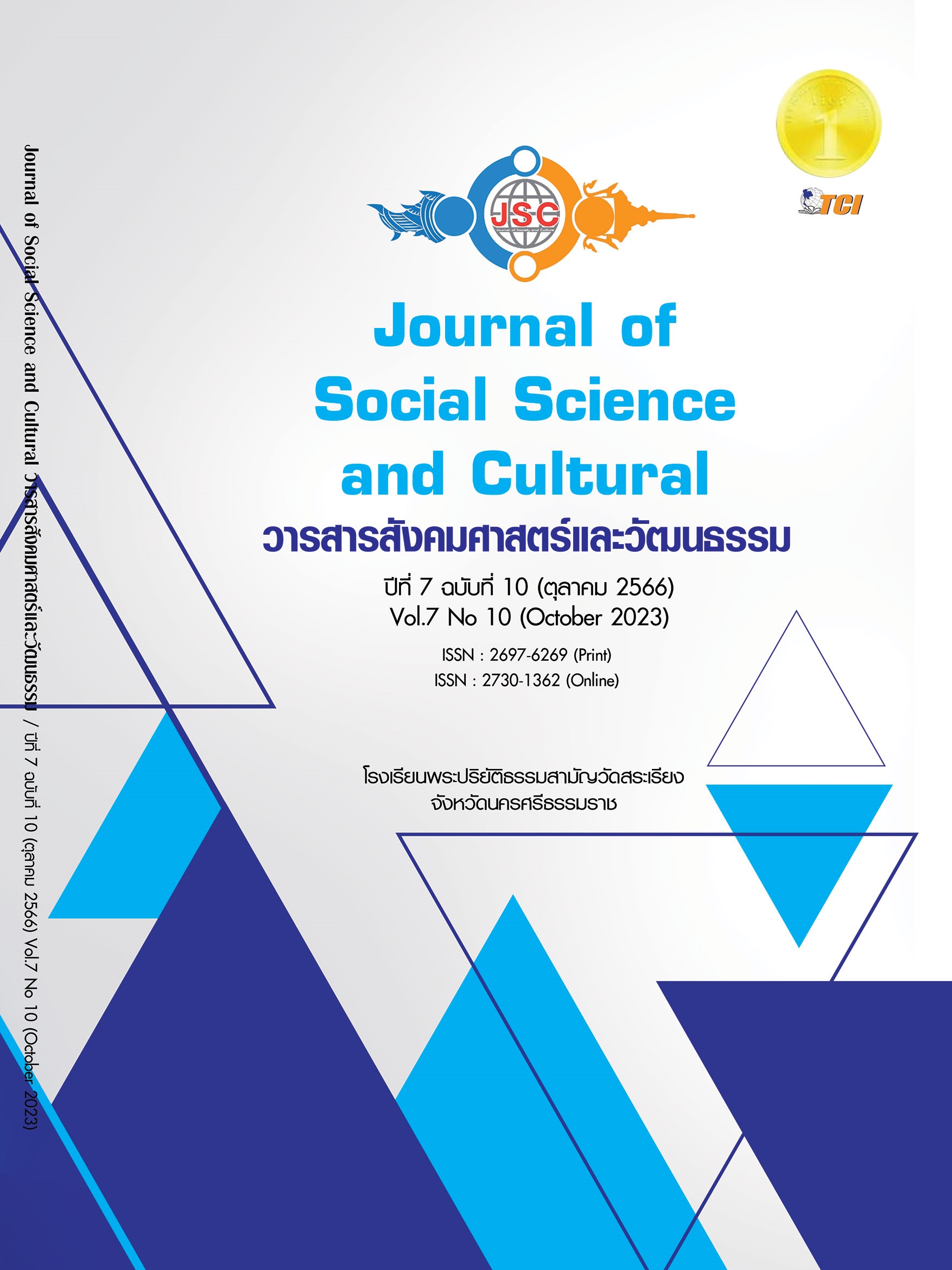MODEL OF PUBLIC SERVICES COLLABORATION OF THE ROYAL IRRIGATION DEPARTMENT IN WATER MANAGEMENT PROJECTS
Main Article Content
Abstract
The aims of research are as follows: 1) to investigate the reasons and process for establishing collaboration in the public service of the Royal Irrigation Department 2) to investigate the element that contribute to the success of the process for establishing collaboration. 3) to create a model for collaboration in the public service of the Royal Irrigation Department, using qualitative research methods. There are key information providers including: Executives of the Royal Irrigation Department and Irrigation Project, operational staff, water users and related organizations totaling 84 people. Using a specific selection method and a snowball sampling method, using semi-structured interview tools using in-depth interviews, non-participant observation and using Qualitative Comparative Analysis. Findings of the study, 1) The Royal Irrigation Department employs the process of collaboration as a strategy to solve personnel shortages and resolve conflicts. 2) The Royal Irrigation Department's tools for water delivery and maintenance the farmers participated in the 14-step process and collaborative dynamics. 3) The researcher has proposed a model of collaboration in the public service of the Royal Irrigation Department that is appropriate in three types, divided into two situations: 1) The area in providing public services is open space, and it has people with disabilities. Many stakeholders have different needs for water in different activities, different amounts of water, and at different times. The water delivery and maintenance the farmers participated in the 14-step process should be used in conjunction with the special collaboration process. 2) The area in providing public services is open space, and it has people with disabilities. Many stakeholders have different needs for water in different activities, different amounts of water, and at different times. Including the closed nature of the area, a small number of stakeholders should implement the water delivery and maintenance the farmers participated in the 14-step process along with collaborative dynamics.
Article Details
References
กระทรวงเกษตรและสหกรณ์. (2563). การบริหารจัดการแหล่งน้ำทั้งระบบ. เรียกใช้เมื่อ 17 พฤศจิกายน 2563 จาก https://www.moac.go.th/a4policy-alltype-421291791792
ชาย โพธิสิตา. (2556). ศาสตร์และศิลป์แห่งการวิจัยเชิงคุณภาพ. (พิมพ์ครั้งที่ 6). กรุงเทพมหานคร: อมรินทร์ พริ้นติ้ง แอนด์ พับลิชชิ่ง จำกัด (มหาชน).
ทิพวรรณ หล่อสุวรรณรัตน์. (2559). ทฤษฎีองค์การสมัยใหม่ Modern Organization Theory. กรุงเทพมหานคร: บริษัท แซทโฟร์ พริ้นติ้ง จำกัด.
สำนักงานเลขาธิการสภาผู้แทนราษฎร. (2560). รัฐธรรมนูญแห่งราชอาณาจักรไทย. เรียกใช้เมื่อ 25 มิถุนายน 2562 จาก https://cdc.parliament.go.th
สำนักส่งเสริมการมีส่วนร่วมของประชาชน. (2552). คู่มือการส่งน้ำและบำรุงรักษาโดยเกษตรกรมีส่วนร่วมตามกระบวนการ 14 ขั้นตอน. กรุงเทพมหานคร: บริษัท บูม คัลเลอร์ ไลน์ จำกัด.
Ansell, C. & Gash, A. (2007). Collaborative Governance in Theory and Practice. Oxford University Press. Journal of Public Administration Research and Theory, Inc, 18(4), 543-572.
Austin, J. E. (2000). Strategic collaboration between nonprofits and businesses. Nonprofit and voluntary sector quarterly, 29(1), 69-97.
Bano, M. (2018). Partnerships and the Good-Governance Agenda:Improving Service Delivery Through State–NGOCollaborations. International Society for Third-Sector Research, 30(6), 1270-1283.
Caduff, C. (2010). Public prophylaxis: Pandemic influenza, pharmaceutical prevention and participatory governance. Department of Social and Cultural Anthropology, University of Zurich, Switzerland. BioSocieties, 5(2), 199-218.
Dare, L. & Evans, M. (2017). Understanding water governance: the case of Australia’s Murray-darling basin. Routledge Taylor & Francis Group, Policy Studies, 38(5), 411-417.
Faulkner, D. & de Rond, M. (2000). Cooperative strategy: Economic, Business and Organizational issues. United Kingdom: Oxford University Press.
Gray, B. (1985). Conditions facilitating interorganizational collaboration. Human Relations, 38(10), 911-936.
Huxham, C. (1996). Creating collaborative advantage. (1 nd ed). London: SAGE Publications.
Kekez, A., et al. (2018). Varieties of collaboration in public service delivery. Routledge Taylor & Francis Group, Policy Design and Practice, 1(4), 243-252.
Kosec, M. & Wantchekon, L. (2018). Can information improve rural governance and service delivery? World Development, 125, 1-13. https://doi.org/10.1016/j.worlddev.2018.07.017.
Kvartiuk, V. (2016). Participation and Local Governance Outcomes: Evidence from Ukraine. International Society for Third-Sector Research, 27(3), 1123-1151.
Mandel, M. & Steelman, T. (2003). Understanding What Can Be Accomplished through Interorganizational Innovations The Importance of Typologies, Context, and. Management Strategies. Public Management Review, 5(2), 197-224.
Merriam, S. B. (1988). Case Study Research in Education: A Qualitative. Approach. Jossey-Bass: San Francisco.
Miles, M. B. & Huberman, A. M. (1994). Qualitative Data Analysis. An Expanded Sourcebook (2nd ed). Thousand Oaks, CA: Sage.
Pollitt, C. (2003). Public management reform: reliable knowledge and international experience. OECD Journal on Budgeting, 3(3), 121-134.
Ragin, C. C. (1989). The Logic of Comparative Method and the Algebra of Logic. Journal of Quantitive Anthropology, 1 (4), 373-389.
Ragin, C. C., et al. (2003). Complexity, generality, and qualitative comparative analysis. Field Methods, 15(4), 323-340.
Resurreccion, B. P., et al. (2004). Officialising strategies: participatory processes and gender in Thailand’s water resources sector. Routledge Taylor & Francis Group, Development in Practice, 14(4), 521-532.
Rihoux, B. & Ragin, C. C. (2009). Configurational Comparative Methods: Qualitative Comparative Analysis and Related Techniques. California: SAGE Publication, Inc.
Selsky, J. W. & Parker, B. (2005). Cross-sector partnerships to address social issues: Challenges to theory and practice. Journal of management, 31(6), 849-873.
Singh, M., et al. (2014). Cultivating “success” and “failure” in policy: participatory irrigation management in Nepal. Routledge Taylor & Francis Group, Development in Practice, 24 (2), 155-173.
Thompson, A. M., et al. (2007). Conceptualizing and Measuring Collaboration . Journal of Public Administration Research and Theory, 19(1), 23-56.
Tonon, G. . (2017). Quality of Life in Communities of Latin Countries. Switzerland: Springer International Publishing AG.
William, P. & Sullivan, H. (2007). Working in Collaboration: Learning from Theory and Practice. Cardiff: National Leadership and Innovation Agency for Healthcare.


